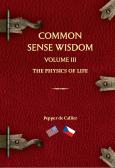What do you know now that would have been helpful to know then?
That we can’t predict the future and success comes from early detection and the flexibility to change.
With the hindsight gained after the crisis it all appears so obvious: the idea that we could use financial models to predict the future seems absurd. However, that’s what I spent many years of my working life concentrating on. I wasn’t alone. As the mathematics of finance became more sophisticated and computing power allowed the development of stochastic models we believed we could predict the future with confidence. On reflection, the sophistication was inversely related to common sense.
I was working for an insurer in risk management. The role of Chief Risk Officer was new. Whilst the idea of risk as something to be measured and controlled was not new, it dates from the renaissance, a job that brought together the analyses and management of all types of risks to ensure the company had sufficient capital to survive in the future was an innovation, even for the insurance industry, whose key role is the management of risk.
Immersed in this new role, together with my team, we built new models and convinced ourselves of our mastery of understanding the future and how we could optimise the group’s capital structure to make greater returns, confident that that the amount of capital was adequate for the risks that might emerge.
But then, even before the financial crisis, I began to have doubts. If the future was capable of being modelled how come we were so poor at maximising risk adjusted returns on our investments? I read the book A Random Walk Down Wall Street that reminded me that the market prices stocks so efficiently that a blindfolded chimpanzee throwing darts at the Wall St Journal can select a portfolio that performs as well as one managed by experts! I listened to these doubts, and this led to a learning journey about how we make decisions that involve the future.
The more I pulled myself away from the detail of my models the more I realised I was making some pretty big, and maybe unsupportable, assumptions. I was assuming that the past was a reliable guide to the future. And I was also assuming I fully understood what had happened in the past. However, the data I was using was only a fragment of all the data: maybe I wasn’t looking over a long enough time period, what if it wasn’t representative?
I thus began to understand complete knowledge of the future – or maybe even of the past – is impossible. Uncertainty is a fact of life and business.
I became interested in how we make decisions in the face of uncertainty: one of the most important tasks of a manager. In fact, predicting the future is something we do all the time, in most cases effortlessly. For example, predicting how long a task will take. In many cases we have a great deal of information guiding our judgments but sometimes we have to make predictions based upon much less evidence. How do we make those predictions?
My learning journey led me to realise that very often we don’t think too much about it. We often rely on intuition or lazy thought processes - the cognitive aspects. Decision makers are prone to heuristics and biases; we rush to decisions without proper analysis.
Certainly there are tools to help us, yet the uncomfortable fact remains that we can’t predict the future. One tool we can use is probability. In probabilistic modelling, risk means an uncertainty for which the probability distribution is known. Yet even when we have the distribution, difficulties can arise from information that is scarce, vague, inconsistent or incomplete.
However, making a decision faced with pure uncertainty, the decision maker has absolutely no knowledge, not even about the likelihood of occurrence for any state of nature.
And finally that the result of our decision making is not always obvious. Every intervention in a complex system has highly complex effects – feedback, time lags and delayed repercussions.
All of this is very challenging. We all find comfort in an ordered world, were we understand the past and have a feeling of confidence about the future. It is hard to acknowledge the deep uncertainties we face in our business and private lives, but to face the future and make good decisions we have acknowledge this reality.
Creating organisations that are resilient under conditions of uncertainty requires new ways of thinking and acting.
Certainly we can use traditional tools; models that project the past into the future. Historical data maybe imperfect, but it remains the only unbiased way to measure risk and make assumptions about the future. But we should be conscious of the tools’ weaknesses and our inability to model true uncertainty.
As predictability diminishes in our turbulent world so the need for buffers and adaptive capacity increases. In my view success will come from the application of a combination of traditional techniques, a good early-warning system that allows change to be identified early and the flexibility to adapt.
Thus any serious corporate strategy must accept that we can’t predict the future, have contingencies and buffers, never plan too far ahead, go easy on details that cannot be controlled and rely on constantly scanning the environment for early signs of change.
Flexibility is ultimately the key to success.




